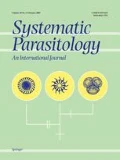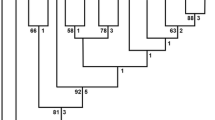Abstract
Taxonomic schemes for the Heteroderinae Filip'ev & Schuurmans Stekhoven, 1941, sensu Luc et al., (1988) have been unstable due to the large number of genera and the paucity of known reliable characters. Reliable characters are essential when using phylogenetic inference in developing a natural classification. Morphological and developmental studies using light, scanning and transmission electron microscopy have revealed the new characters of host response, en face patterns, phasmid structure and female cuticular layers. These techniques also gave us insight into the homoplasy and polarity of many characters, revealed previously undetected character states and clarified misinterpreted character states. A matrix with the 19 most reliable characters is proposed for 20 operational taxonomic units (OTUs) and we employ this matrix for comparing computer generated phylogenetic analyses of the PHYLIP and PAUP packages. PAUP was deemed the more reliable parsimony algorithm for phylogenetic analysis of the Heteroderinae (Fink, 1986; Platnick, 1987). Monophyly of Atalodera + Sherodera + Thecavermiculatus (tribe Ataloderini), and Cactodera + Heterodera + Afenestrata, as well as Punctodera + Globodera + Dolichodera is supported by both programs. Most importantly, analyses strongly support monophyly of all cyst-forming genera (tribe Heteroderini) contrary to previous hypotheses of repeated evolution of the cyst (Wouts, 1985). In addition, monophyly of the Heteroderini with the Ataloderini is demonstrated. PAUP indicates monophyly of Sarisodera + Rhizonema + Bellodera + Hylonema and Ekphymatodera (tribe Sarisoderini new rank). Monophyly of the Sarisoderini was at first only weakly supported, but, subsequently, the reduced width of the submedial lips of second stage juveniles and males was recognized as a synapomorphy which strengthened subsequent PAUP trees and monophyly of the tribe. The present study rejects as paraphyletic or polyphyletic several previously proposed combinations, including Thecavermiculatus sequoiae (versus Rhizonema sequoiae), Sarisodera africana (versus Afenestrata africana), Dolichodera andinus (versus Thecavermiculatus andinus). The question whether T. andinus is a distinct genus, was not resolved due to insufficient data. PAUP supports our previous observations that Cactodera betulae is intermediate in a transformation series between other Cactodera and Heterodera: it also indicates these species as bring monophyletic with Heterodera + Afenestrata, but not with other Cactodera. Although these phylogenetic analyses strongly support some relationships, they indicate unresolved alternative hypotheses for others. Meloidodera (tribe Meloidoderini) and Cryphodera (tribe Cryphoderini) must be investigated for consideration of a possible synapomorphy not included in the present data matrix. Future studies are proposed to more clearly define the monophyly of the Heteroderini, as well as the Sarisoderini. Tests are also proposed to clarify questions of the monophyly of Verutus (tribe Verutini new rank) with the Heteroderinae versus other Tylenchida.
Similar content being viewed by others
References
Baldwin, J.G. (1983) Fine structure of body wall cuticle of females of Meloidodera charis, Atalodera lonicerae and Sarisodera hydrophila (Heteroderidae). Journal of Nematology, 15, 370–381.
Baldwin, J.G. (1985) Fine structure of the phasmid of second-stage juveniles of Heterodera schachtii (Tylenchida: Nematoda). Canadian Journal of Zoology 63, 534–542.
Baldwin, J.G. (1986) Testing hypotheses of phylogeny of Heteroderidae. In: Lamberti, F. & Taylor, C.E. (Ed.) Cyst nematodes. New York: Plenum Publishing Corporation, pp. 75–100.
Baldwin, J.G., Mundo-Ocampo, M. & Othman, A.A. (1983) Cryphodera utahensis n. sp. (Heteroderidae), a new species from wild rose in Utah. Journal of Nematology, 15, 182–191.
Baldwin, J.G. & Powers, T.O. (1987) Use of fine structure and nucleic acid analysis in systematics,. In Veech, J.A. Dickson, D.W. (Ed.) Vistas, publication of Society of Nematologists. Lawrence, Kansas: Allen Press, pp. 336–353.
Baldwin, J.G., Bernard, E.C. & Mundo-Ocampo, M. (1989) Four new species of Heteroderidae including Ekphymatodera n. gen., from California. Journal of Nematology, 21, (in press)
Camin, J.H. & Sokal, R.R. (1965) A method for deducing branching sequences in phylogeny. Evolution 19, 311–326.
Carta, L.K. & Baldwin, J.G. (1987) Fine structure of phasmid development in males of Meloidodera floridensis. Journal of Nematology 19, 517 [Abstract].
Carta, L.K. & Baldwin, J.G. (1990a) Phylogenetic implications of phasmid development in Meloidodera spp. (Heteroderinae). Journal of Nematology (In press).
Carta, L.K. & Baldwin, J.G. (1990b) Phylogenetic implications of phasmid absence in males of three Heteroderinae. Journal of Nematology (In press).
Cliff, G.M. & Baldwin, J.G. (1985) Fine structure of the body wall cuticle of females of eight genera of Heteroderidae. Journal of Nematology 17, 286–296.
Coomans, A. (1979) General principles of systematics with particular reference to speciation. In: Lamberti, F. & Taylor, C. E. (Eds) Root-knot nematodes (Meloidogyne species). Systematics, biology and control. London: Academic Press, pp. 1–19.
Cohn, E., Kaplan, D.T. & Esser, R.P. (1984) Observations on the mode of parasitism and histopathology of Meloidodera floridensis and Verutus volvingentis (Heteroderidae). Journal of Nematology, 16, 256–264.
Eldredge, N. & Cracraft, J. (1980) Phylogenetic patterns and the evolutionary process method and theory in comparative biology. New York: Columbia University Press, 349 pp.
Felsenstein, J. (1979) Alternative methods of phylogenetic inference and their interrelationship. Systematic Zoology, 28, 49–62.
Felsenstein, J. (1981) The statistical approach to inferring evolutionary trees and what it tells us about parsimony and compatibility. In: Duncan, T. & Stressy, T.F. (Eds). Cladistics: Perspectives on the reconstruction of evolutionary history. New York: Columbia University Press, pp. 170–191.
Felsenstein, J. (1984) Distance methods for inferring phylogenies: a justification. Evolution, 38, 16–24.
Ferris, V.R. (1979) Cladistic approaches in study of soil and plant parasitic nematodes. American Zoologist, 19, 1195–1215.
Ferris, V.R. (1985) Evolution and biogeography of cyst-forming nematodes. OEPP/EPPO Bulletin, 15, 123–129.
Fink, W.L. (1986) Microcomputers and phylogenetic analysis. Science, N.Y., 234, 1135–1139.
Geraert, E. (1981) The female reproductive system in nematode systematics. Annales de la Societe Royale Zoologique de Belgique, 110, 73–86.
Geraert, E. & DeGisse, A. (1981) The male copulatory system in tylenchid taxonomy (Nematoda). Nematologica, 27, 432–442.
Golden, A.M. (1970) Classification of the genera and higher categories of the order Tylenchida (Nematoda). In: Zuckerman, W., Mai, F. & Rohde, R.A. (Eds) Plant Parasitic nematodes Vol. 1. New York: Academic Press, pp. 191–232.
Golden, A.M. (1986) Morphology and identification of cyst nematodes. In: Lamberti, F. & Taylor, C.E. (Eds) Cyst nematodes. New York: Plenum Press, pp. 23–45.
Golden, A.M. & Raski, D.J. (1977) Heterodera thornei n. sp. (Nematoda: Heteroderidae) and a review of related species. Journal of Nematology, 9, 93–112.
Hennig, W. (1966) Phylogenetic systematics. (Translated by D. Dwight Davis and Rainer Zangerl). Urbana: University of Illinois Press, 263 pp.
Humphries, C.J. (Ed) (1988) Ontogeny and systematics. New York: Columbia University Press, 236 pp.
Krall, E. & Krall, H. (1978) The revision of plant nematodes of the family Heteroderidae (Nematoda: Tylenchida) by using a comparative ecological method of studying their phylogeny. In: Fitogel' mitologicheskie issledovaniya. Moscow: USSR Nauka, pp. 39–56 (In Russian).
Luc, M., Taylor, D.P. & Cadet, P. (1978) Description of a new tropical Heteroderidae, Hylonema ivorense n. gen., n. sp., and a new outlook for the family Heteroderidae (Nematoda: Tylenchida). Revue de Nematologie, 1, 73–86.
Luc, M., Weischer, B., Stone, A.R. & Baldwin, J.G. (1986) On the definition of heteroderid cysts. Revue de Nematologie, 9, 418–421.
Luc, M., Maggenti, A.R. & Fortuner, R. (1988) A reappraisal of Tylenchina (Nemata). The family Heteroderidae Filip'ev & Schuuramans Stekhoven, 1941. Revue de Nematologie, 11, 159–176.
Mulvey, R.H. (1973) Morphology of the terminal areas of white females and cysts of the genus Heterodera (e.g. Globodera). Journal of Nematology, 5, 303–311.
Mulvey, R.H. & Golden, A.M. (1983). An illustrated key to the cyst-forming genera and species of Heteroderidae in the western hemisphere with species morphometrics and distribution. Journal of Nematology, 15, 1–59.
Mulvey, R.H. & Ebsary, B.A. (1980) Dolichodera fluvialis n. gen., n. sp. (Nematoda: Heteroderidae) from Quebec, Canada. Canadian Journal of Zoology, 58, 1697–1702.
Mundo-Ocampo, M. & Baldwin, J.G. (1983a) Host-parasite relationships of Atalodera spp. (Heteroderidae). Journal of Nematology, 15, 234–243.
Mundo-Ocampo, M. & Baldwin, J.G. (1983b) Host response to Sarisodera hydrophila Wouts and Sher, 1971. Journal of Nematology, 15, 259–268.
Mundo-Ocampo, M. & Baldwin, J.G. (1983c) Host responses to Meloidodera spp. (Heteroderidae). Journal of Nematology, 15, 544–554.
Mundo-Ocampo, M. & Baldwin, J.G. (1984) Comparative host response of Cryphodera utahensis with other Heteroderidae and a discussion of phylogeny. Proceedings of the Helminthological Society of Washington, 51, 25–31.
Nelson, G.J. (1972) Phylogenetic relationship and classification. Systematic Zoology, 21, 227–231.
Nelson, G.J., (1974) Classification as an expression of phylogenetic relationships. Systematic Zoology, 22, 344–359.
Othman, A.A. (1985) Comparison of characters with SEM, for systematics and phylogeny of Heteroderidae (Nematoda: Tylenchida). Ph.D. thesis: University of California Riverside, 183 pp.
Othman, A.A. & Baldwin, J.G. (1985a) Comparative morphology of Meloidodera spp. and Verutus sp. (Heteroderidae) with scanning electron microscopy. Journal of Nematology, 17, 297–309.
Othman, A.A. & Baldwin, J.G. (1985b) Comparative morphology of Sarisodera hydrophila, Rhizonema sequoiae, and Afenestrata africana (Heteroderidae) with scanning electron microscopy. Proceedings of the Helminthological Society of Washington, 53, 69–79.
Othman, A.A., Baldwin, J.G. & Bell, A.H. (1986) Comparative morphology of Atalodera spp. and Thecavermiculatus spp. (Heteroderidae) with scanning electron microscopy. Journal of Nematology, 18, 275–287.
Othman, A.A., Baldwin, J.G. & Mundo-Ocampo, M. (1988) Comparative morphology of Globodera, Cactodera, and Punctodera spp. (Heteroderidae) with scanning electron microscopy. Revue de Nematologie, 20, 53–63.
Platnick, N.I. (1987) An empirical comparison of microcomputer parsimony programs. Cladistics, 3, 121–144.
Rieger, R. & Tyler, S. (1979) The homology theorem in ultrastructural research. American Zoologist, 19, 655–664.
Shepherd, A.M., Clark, S.A. & Dart, P.J. (1972) Cuticle structure in the genus Heterodera. Nematologica, 18, 1–17.
Siddiqi, M.R. (1986) Tylenchida: parasites of plants and insects. Farnham Royal: Commonwealth Agricultural Bureaux International, 645 pp.
Stone, A.R. (1975) Head morphology of second-stage juveniles of some Heteroderidae (Nematoda: Tylenchoidea). Nematologica, 21, 81–88.
Suarez, Z., Sosa Moss, C. & Inserra, R.N. (1985) Anatomical changes induced by Punctodera chalcoensis in corn roots. Journal of Nematology, 17, 242–244.
Triantaphyllou, A.C. & Hirschmann, H. (1973) Environmentally controlled sex expression in Meloidodera floridensis. Journal of Nematology, 5, 181–184.
Wiley, E.O., (1981) Phylogenetics the theory and practice of phylogenetic systematics. New York: John Wiley & Sons, 439 pp.
Wouts, W.M. (1973). A revision of the family Heteroderidae (Nematoda: Tylenchoidea). Nematologica, 19, 279–284
Wouts, W.M. (1985) Phylogenetic classification of the family Heteroderidae (Nematoda: Tylenchida). Systematic Parasitology, 7, 295–328.
Wouts, W.M. & Sher, S.A. (1971) The genera of the subfamily Heteroderinae (Nematoda: Tylenchoidea) with a description of two new genera. Journal of Nematology, 3, 129–144.
Author information
Authors and Affiliations
Rights and permissions
About this article
Cite this article
Baldwin, J.G., Schouest, L.P. Comparative detailed morphology of the Heteroderinae Filip'ev & Schuurmans Stekhoven, 1941, sensu Luc et al. (1988): phylogenetic systematics and revised classification. Syst Parasitol 15, 81–106 (1990). https://doi.org/10.1007/BF00009986
Accepted:
Issue Date:
DOI: https://doi.org/10.1007/BF00009986




